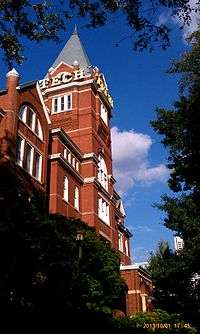Georgia Institute of Technology School of Computational Science & Engineering
| Type | Public |
|---|---|
| Established | 2010[1] |
| Chair | David A. Bader[2] |
Academic staff | 17[3] |
| Postgraduates | 87[4] |
| Location |
Atlanta, Georgia, 33°46′39″N 84°23′46″W / 33.777524°N 84.3961°WCoordinates: 33°46′39″N 84°23′46″W / 33.777524°N 84.3961°W |
|
| |
The School of Computational Science & Engineering is an academic unit located within the College of Computing at the Georgia Institute of Technology (Georgia Tech). It conducts both research and teaching activities related to computational science and engineering at the undergraduate and graduate levels. These activities focus on "making fundamental advances in the creation and application of new computational methods and techniques in order to enable breakthroughs in scientific discovery and engineering practice."[5]
History
The School of Computational Science & Engineering was formed in March 2010, when the former Computational Science and Engineering Division was elevated to "School" status. Richard Fujimoto was appointed as the school's first chair. The School of Computational Science & Engineering represents a continuation of the College of Computing’s efforts to define and delineate the field of computing into focused bodies of study.[1] In July 2014, David A. Bader, replaced Fujimoto as school chair.[2]
Degrees offered
The School of Computational Science & Engineering offers bachelor's degrees, master's degrees, and doctoral degrees in several fields.[6] These degrees are technically granted by the School's parent organization, the Georgia Tech College of Computing, and often awarded in conjunction with other academic units within Georgia Tech.
Doctoral degrees
- Ph.D. in Bioengineering
- Ph.D. in Bioinformatics
- Ph.D. in Computational Science & Engineering
- Ph.D. in Computer Science
Master's degrees
- M.S. in Analytics
- M.S. in Bioengineering
- M.S. in Computational Science & Engineering
- M.S. in Computational Science & Engineering Distance Learning
- M.S. in Computer Science
Bachelor's degrees
- B.S. in Computer Science
Notable faculty
Location
The School of Computational Science & Engineering’s administrative offices, as well as those of most of its faculty and graduate students, are located in the Klaus Advanced Computing Building.
See also
References
- 1 2 "GT Announces New School of CSE" (Press release). Georgia Institute of Technology. 2010-03-04. Retrieved 2014-09-30.
- 1 2 "College of Computing Picks Bader to Lead School of CSE" (Press release). Georgia Tech College of Computing. March 25, 2014. Retrieved 2014-09-30.
- ↑ "CSE Faculty Positions". Georgia Institute of Technology College of Computing. Retrieved 2014-09-30.
- ↑ "IRP Self-Service Reports". Georgia Institute of Technology Office of Institutional Research and Planning. Retrieved 2014-09-30.
- ↑ "About the School of Computational Science & Engineering". Georgia Institute of Technology College of Computing. Retrieved 2014-09-30.
- ↑ "Future Students". Georgia Institute of Technology College of Computing. Retrieved 2014-09-30.
